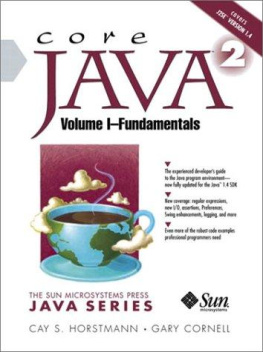Cay S. Horstmann - Core Java, Volume II: Advanced Features
Here you can read online Cay S. Horstmann - Core Java, Volume II: Advanced Features full text of the book (entire story) in english for free. Download pdf and epub, get meaning, cover and reviews about this ebook. year: 2016, publisher: Prentice Hall, genre: Computer. Description of the work, (preface) as well as reviews are available. Best literature library LitArk.com created for fans of good reading and offers a wide selection of genres:
Romance novel
Science fiction
Adventure
Detective
Science
History
Home and family
Prose
Art
Politics
Computer
Non-fiction
Religion
Business
Children
Humor
Choose a favorite category and find really read worthwhile books. Enjoy immersion in the world of imagination, feel the emotions of the characters or learn something new for yourself, make an fascinating discovery.

- Book:Core Java, Volume II: Advanced Features
- Author:
- Publisher:Prentice Hall
- Genre:
- Year:2016
- Rating:4 / 5
- Favourites:Add to favourites
- Your mark:
Core Java, Volume II: Advanced Features: summary, description and annotation
We offer to read an annotation, description, summary or preface (depends on what the author of the book "Core Java, Volume II: Advanced Features" wrote himself). If you haven't found the necessary information about the book — write in the comments, we will try to find it.
Core Java has long been recognized as the leading, no-nonsense tutorial and reference for experienced programmers who want to write robust Java code for real-world applications. Now, Core Java, Volume IIAdvanced Features, Tenth Edition, has been extensively updated to reflect the most eagerly awaited and innovative version of Java in years: Java SE 8. Rewritten and reorganized to illuminate powerful new Java features, idioms, and best practices for enterprise and desktop development, it contains hundreds of up-to-date example programsall carefully crafted for easy understanding and practical applicability.
Writing for serious programmers solving real-world problems, Cay Horstmann deepens your understanding of todays Java language and library. In this second of two updated volumes, he offers in-depth coverage of advanced topics including the new Streams API and date/time/calendar library, advanced Swing, security, code processing, and more. This guide will help you
- Use the new Streams library to process collections more flexibly and efficiently
- Efficiently access files and directories, read/write binary or text data, and serialize objects
- Work with Java SE 8s regular expression package
- Make the most of XML in Java: parsing, validation, XPath, document generation, XSL, and more
- Efficiently connect Java programs to network services
- Program databases with JDBC 4.2
- Elegantly overcome date/time programming complexities with the new java.time API
- Write internationalized programs with localized dates/times, numbers, text, and GUIs
- Process code with the scripting API, compiler API, and annotation processors
- Enforce security via class loaders, bytecode verification, security managers, permissions, user authentication, digital signatures, code signing, and encryption
- Master advanced Swing components for lists, tables, trees, text, and progress indicators
- Produce high-quality drawings with the Java 2D API
- Use JNI native methods to leverage code in other languages
If youre an experienced programmer moving to Java SE 8, Core Java, Tenth Edition, is the reliable, practical, and complete guide to the Java platform that has been trusted by developers for over twenty years.
Look for the companion volume, Core Java, Volume IFundamentals, Tenth Edition (ISBN-13: 978-0-13-417730-4), for foundational coverage of Java 8 language concepts, UI programming, objects, generics, collections, lambda expressions, concurrency, functional programming, and more.
Cay S. Horstmann: author's other books
Who wrote Core Java, Volume II: Advanced Features? Find out the surname, the name of the author of the book and a list of all author's works by series.




